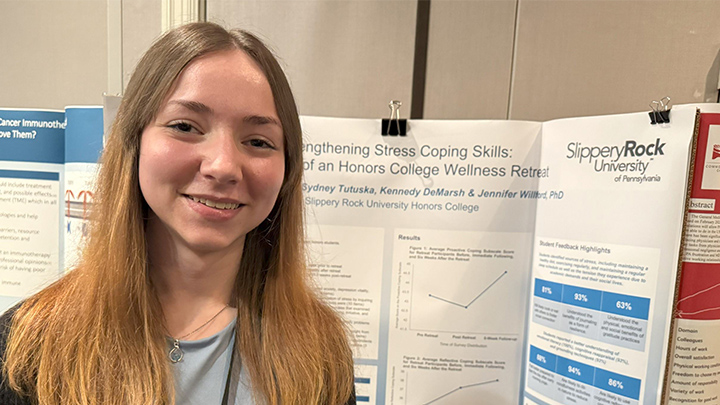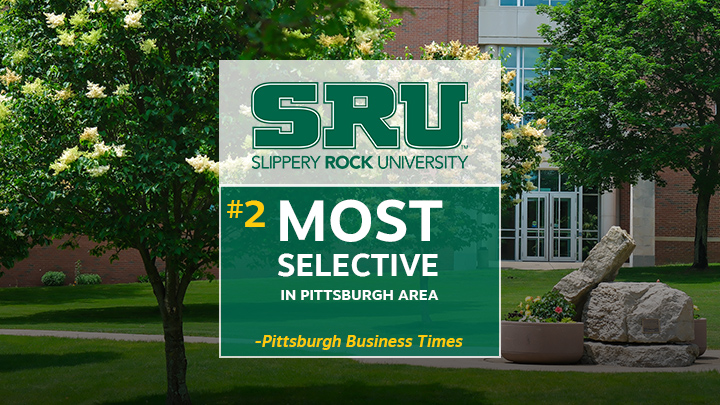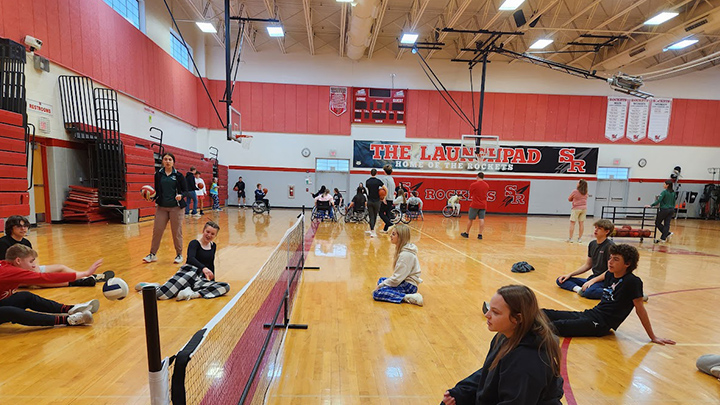“Breaking Down Barriers: Slippery Rock University Students Revolutionize Disability Sports at Local High School”
In a heartwarming display of compassion, leadership, and dedication, a group of students from Slippery Rock University has taken it upon themselves to launch a groundbreaking disability sports program at a local high school. This extraordinary initiative not only brings attention to the often-overlooked world of adaptive athletics but also serves as a shining example of the transformative power of education and community engagement.

As part of their commitment to community outreach and service, a team of SRU students has partnered with the local high school to create an inclusive sports environment that caters to students with disabilities. From wheelchair basketball to track and field, the program offers a wide range of activities designed to promote physical fitness, social interaction, and personal growth among participants.

Pittsburgh Business Times Reveals SRU’s Selectivity Ranking
Slippery Rock University has solidified its position as a top-tier institution in the Pittsburgh area, according to recent data analyzed by the Pittsburgh Business Times (PBT). In a comprehensive analysis, the PBT revealed SRU as the #2 most selective colleges and universities in the Pittsburgh area, and #11 most selective colleges and universities in Pennsylvania. This ranking underscores the university’s commitment to academic excellence and attracting top talent.
The PBT analysis, conducted by its parent company, The Business Journals, used a weighted formula that considered both acceptance rates and matriculation rates. The matriculation rate measures how well colleges turn accepted applicants into enrolled students. SRU’s impressive 33.7% matriculation rate ranked 97th nationally, outpacing many of its peer institutions.
Notably, SRU’s high acceptance rate of 74.6% belies its selectivity, as the university is able to turn a significant proportion of accepted applicants into enrolled students. Among the 4,566 students accepted, 1,537 enrolled in the Butler County college that is part of the Pennsylvania State System of Higher Education. This level of success is a testament to the university’s ability to attract and retain top students.
Carnegie Mellon, a nationally renowned private research university, ranked #1 on the list for the Pittsburgh area. However, the PBT authors noted that “the number two school in the analysis may come as a surprise.” This ranking highlights SRU’s status as a rising star in the world of higher education, and its commitment to academic excellence and student success.
Factors Contributing to SRU’s High Matriculation Rate: Analysis and Implications
So, what drives SRU’s high matriculation rate? Several factors contribute to this success, including the university’s strong reputation, excellent academic programs, and commitment to student support. One key factor is the university’s focus on student engagement and retention, which includes initiatives such as academic advising, mentorship programs, and extracurricular activities.
Another important factor is SRU’s commitment to accessibility and inclusivity. The university’s Disability Sports Course, for example, provides students with the opportunity to engage with adapted physical activity and promote inclusion in their communities. This commitment to accessibility and inclusivity helps to create a welcoming environment for students of all backgrounds and abilities.
Additionally, SRU’s faculty and staff play a critical role in supporting student success. The university’s faculty members are dedicated to teaching and mentoring, and are often involved in research and community engagement initiatives. This commitment to excellence in teaching and research helps to create a vibrant academic environment that fosters student growth and development.
The implications of SRU’s high matriculation rate are significant. By attracting and retaining top students, the university is able to maintain its academic excellence and reputation. This, in turn, helps to attract more high-quality students, faculty, and staff, creating a cycle of excellence that benefits the entire university community.
Comparison with Carnegie Mellon: A Nationally Renowned Private Research University
Carnegie Mellon, a nationally renowned private research university, ranked #1 on the list for the Pittsburgh area. While both universities share a commitment to academic excellence, there are significant differences in their profiles and approaches. Carnegie Mellon is a private university with a strong focus on research and innovation, while SRU is a public university with a focus on teaching and community engagement.
One key difference is in their selectivity. Carnegie Mellon has a significantly lower acceptance rate of 15.4%, compared to SRU’s 74.6%. This reflects the differences in their admissions criteria and priorities. Carnegie Mellon places a strong emphasis on academic achievement and research potential, while SRU prioritizes a broader range of factors, including community engagement and extracurricular activities.
Despite these differences, both universities share a commitment to excellence in teaching and research. Carnegie Mellon’s faculty members are renowned for their expertise and innovation, and the university is a leader in fields such as computer science, engineering, and business. SRU, on the other hand, is recognized for its strong programs in education, health sciences, and the arts.
The comparison between SRU and Carnegie Mellon serves as a reminder that there is no one “right” way to approach higher education. Both universities have their unique strengths and approaches, and both are committed to excellence in teaching and research.
The Impact of Inclusive Initiatives: Empowering Students and the Community
Changing Perceptions and Promoting Inclusion through Adapted Physical Activity
The Disability Sports Course at SRU is an excellent example of how inclusive initiatives can promote social change and empower students and communities. By engaging with adapted physical activity, students are able to challenge their own perceptions and biases, and develop a deeper understanding of the experiences of individuals with disabilities.
One key outcome of this course is the development of a more inclusive and welcoming environment on campus. By promoting awareness and understanding of disability issues, students are able to create a more supportive and inclusive community that values diversity and promotes social change.
Moreover, the Disability Sports Course has a broader impact on the community beyond the campus. The course provides students with the skills and knowledge to promote inclusion and accessibility in their own communities, creating a ripple effect that can lead to positive social change.
The Role of Education in Fostering Inclusive Environments
Education plays a critical role in fostering inclusive environments. By promoting awareness and understanding of disability issues, educators can help to create a more supportive and inclusive community that values diversity and promotes social change.
One key strategy for promoting inclusion is through education and awareness-raising initiatives. By providing students with the knowledge and skills to promote inclusion and accessibility, educators can help to create a more supportive and inclusive community that values diversity and promotes social change.
Moreover, education can also help to challenge stereotypes and misconceptions about disability, promoting a more nuanced and informed understanding of the experiences of individuals with disabilities.
Practical Applications and Future Directions for Disability Sports Programs
So, what are the practical applications of disability sports programs? One key outcome is the development of a more inclusive and welcoming environment on campus and in the community. By promoting awareness and understanding of disability issues, students are able to create a more supportive and inclusive community that values diversity and promotes social change.
Moreover, disability sports programs can also provide students with the skills and knowledge to promote inclusion and accessibility in their own communities, creating a ripple effect that can lead to positive social change.
Looking to the future, there are many areas of growth and development for disability sports programs. One key area is the development of more inclusive and accessible facilities and services. By providing students with the resources and support they need to succeed, educators can help to create a more inclusive and supportive community that values diversity and promotes social change.
SRU’s Adapted Physical Activity Minor: Empowering Students to Make a Difference
Overview of the Program and its Unique Aspects
The Adapted Physical Activity Minor at SRU is a unique and innovative program that prepares students to work with individuals with disabilities in a variety of settings. The program provides students with the knowledge and skills to promote inclusion and accessibility, and to create a more supportive and inclusive community that values diversity and promotes social change.
One key aspect of the program is its focus on practical application. Students in the program are able to gain hands-on experience working with individuals with disabilities, and to develop the skills and knowledge they need to succeed in this field.
Student Testimonials: Personal Experiences and Career Aspirations
Students in the Adapted Physical Activity Minor at SRU have a wide range of personal experiences and career aspirations. One student, for example, is interested in working with individuals with autism, and is using the skills and knowledge she gained in the program to develop her own inclusive sports program for this population.
Another student is interested in working in the field of adaptive sports, and is using the program to develop her skills and knowledge in this area. Through the program, she has gained experience working with individuals with physical disabilities, and has developed a deeper understanding of the experiences of individuals with disabilities.
These testimonials highlight the impact of the Adapted Physical Activity Minor at SRU. By providing students with the knowledge and skills they need to succeed, the program is empowering students to make a difference in the lives of individuals with disabilities.
Future Prospects and Opportunities for the Adapted Physical Activity Minor
Looking to the future, there are many areas of growth and development for the Adapted Physical Activity Minor at SRU. One key area is the development of more inclusive and accessible facilities and services. By providing students with the resources and support they need to succeed, educators can help to create a more inclusive and supportive community that values diversity and promotes social change.
Another key area is the expansion of the program to include more courses and specializations. By providing students with a wider range of options, the program can help to attract a more diverse range of students, and to prepare students for a wider range of careers and opportunities.
Finally, the program can also benefit from partnerships and collaborations with other organizations and institutions. By working together, educators can help to create a more inclusive and supportive community that values diversity and promotes social change.
Conclusion
In conclusion, the innovative disability sports program led by students at Slippery Rock University’s local high school has shattered conventional barriers, empowering students with disabilities to discover their athletic potential and fostering a culture of inclusivity. As highlighted in this article, the program’s success is attributed to the dedication and passion of the student leaders, who have not only created a safe and supportive environment but have also provided opportunities for socialization, skill-building, and personal growth.
The significance of this initiative extends far beyond the boundaries of the high school, as it sets a precedent for other educational institutions to follow suit. By promoting disability sports, we can challenge traditional notions of ability and disability, encouraging a more nuanced understanding of diversity. Moreover, this program serves as a testament to the power of student-led initiatives, demonstrating that young people have the capacity to drive meaningful change and create lasting impacts on their communities.
As we move forward, it is essential that we continue to prioritize accessibility and inclusivity in our educational systems, recognizing the transformative potential of disability sports. By doing so, we can unlock the full potential of students with disabilities, empowering them to become agents of change and leaders in their own right. As the student leaders of this program so aptly demonstrate, “disability” is not a limitation, but rather a unique perspective that can enrich our collective understanding of what it means to be human.
